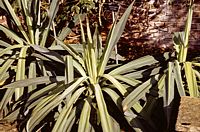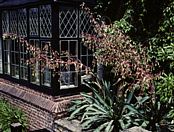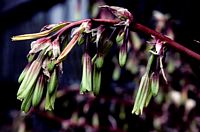Agavaceae
In the American continent, the succulent monocotyledons have diverged into a number of important families of succulent plants, including the Agavaceae which form distinctive rosettes and flower spikes. The Agavaceae family includes Agave, Beschorneria, Furcraea, Hesperaloe, Hesperocallis, Manfreda, Polianthes, Prochnyanthes, and Yucca.
The genera Beaucarnea, Calibanus, Dasylirion and Nolina were formerly included in the Agavaceae but are now generally regarded as members of the Nolinaceae. The Old World Dracenaceae were also once grouped with the Agave family but are now in a family of their own.
You can download higher quality images by clicking on the pictures below.
|
Beschorneria Kunth 1850
There are 7 species of Beschorneria, growing in high mountains and forests of Mexico and Guatemala. All species except one consist of polycarpic stemless rosettes of large, succulent lanceolate leaves, mostly without marginal teeth or terminal spine, spreading freely via rhizomes. Beschorneria albiflora is unique in having a substantial stem. The inflorescence carries groups of pendulous tubular flowers under brightly coloured bracts. Members of this genus will only tolerate moderate cold and should be protected from severe frost.
|
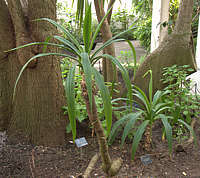
Beschorneria albiflora Matuda 1974
Syn: Beschorneria chiapensis Matuda 1986 (nom inval.)
The rosette of lanceolate succulent leaves is carried on a thick stem, which may extend to several feet along the ground, curving up at the end. Despite the albiflora epiphet, the flowers are only briefly white becoming a pale pink which darkens with age. The long, branched flower stem is bright red.
Photographed growing as an understory plant in the Temperate House, RBG Kew.
Typical habitat of Beschorneria albiflora is moist oak forest on mountains of the South-Mexican states of Oaxaca and Chiapas, Guatamala and Honduras. Growing at altitudes of 6600 ft, it is said to withstand a little frost but probably best for gardens in a mild or Mediterranean climate. The fresh flowers are eaten fried in egg.
|

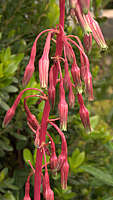 |
Beschorneria septentrionalis García-Mendoza 1988
The foliage consists of rosettes of narrow, soft, strap-like succulent leaves. The inflorescence is a bright red 5 ft tall panicle with 4 to 6 branches, bearing clusters of pendulous, tubular, waxy red flowers with green tips. Only the top of the flower stem is shown here.
Native to North-Eastern Mexico and the most Northerly species of Beschorneria, said to tolerate slight frost. A very showy succulent plant which is attractive to humming birds.
|
|
|
Furcraea Ventenat 1793
About 20 species of Furcraea are included within the Agavaceae. Some species have a neat stemless rosette, as seen here, but others produce a huge trunk felted with old leaves. All species are monocarpic, like Agaves. As they are distributed from central Mexico, Caribbean islands and central S. America, all species are relatively tender compared with many Agaves and will only tolerate the mildest of frosts.
|
For Furcraea australis see: Doryanthes
|
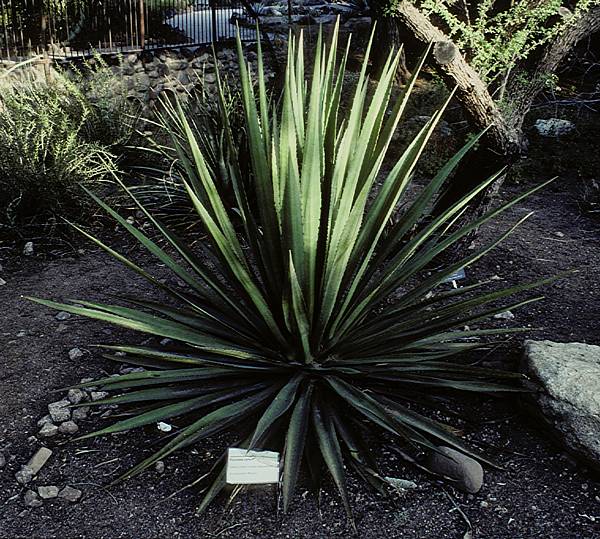
Furcraea cahum Trelease 1910
from the Yucatan, Mexico is similar to F. hexapetala. The rosette of 4-6 ft succulent leaves with sharp marginal teeth, develops a short 3 ft stem with age. The inflorescence up to 15 ft tall bears slightly pubescent yellowish green flowers, followed by many bulbils. This plant is a source of fibre for sacking and ropes.
Photographed in the Desert Botanic Garden, Phoenix, Arizona.
|

Furcraea foetida Haworth 1812 (Mauritius Hemp)
is native to Northern S. America, but widely planted in Mediterranean climates. It is used as a commercial fibre crop, especially on the island of Mauritius.
The rosette is similar to that of F. selloa but there are fewer marginal teeth and no trunk, or occasionally only a very short one. The inflorescence of greenish-white, perfumed flowers may be up to 25 ft tall. Flowers are followed by bulbils which may be used to propagate new plants.
This specimen is a variegated cultivar, possibly F. foetida var. medio-picta. Photograph: Lowell B. Smith, Kingston, Jamaica.
|

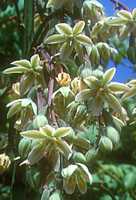 |
Furcraea longaeva Karwinsky & Zuccarini 1812
This tender Southern Mexican succulent plant is noted for producing a huge inflorescence over 40 ft tall. The decorative pendant flowers are slightly hairy (pubescent) on their exterior and are later replaced by bulbils which produce the next generation of plants. The pliable succulent leaves forming the rosette have smooth margins and lack the surgically sharp terminal spine of many Agaves, so are non-hazardous and suitable as Summer bedding plants near paths as visitor-friendly architectural plants.
Photographed in flower at RHS Wisley. June 2004. The 12ft spike shown here is rather small for this species. |
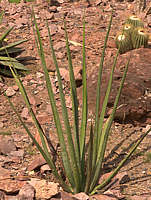 |
Furcraea macdougalii Matuda 1955 (Macdougal's Giant Century Plant)
This species is the tallest Furcraea with a large trunk up to 20 ft tall bearing a distinctive rosette of upright, narrow (2-3 in), long (6 ft) concave leaves with hooked, light brown teeth along the margins. The leaves are quite succulent, especially near their base. Mature plants with at least 8 ft trunks produces a large (25 ft) branched inflorescence has many pendulous greenish-white flowers, followed by bulbils.
Native to a small area of dry scrub forests in the Mexican state, Oaxaca. The small trunkless succulent plant shown here bedded out at RBG Kew, UK will probably take at least 25 years to reach flowering size.
|
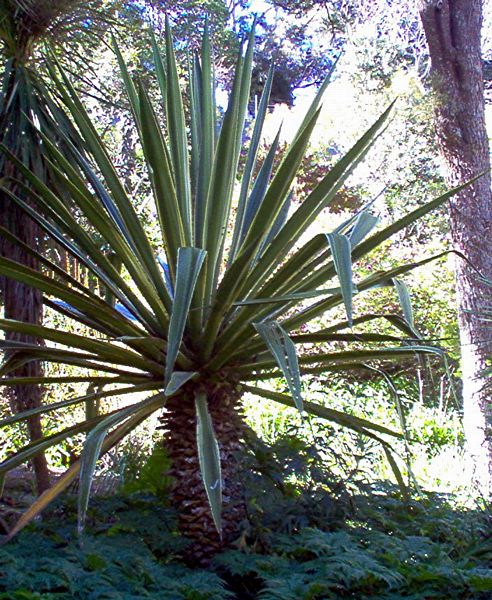 |
Furcraea selloa K. Koch 1860
has a striking rosette of stiff 4 ft sword-shaped green succulent leaves up to 3 in wide and furnished with sharp marginal teeth. The plant develops a short stout trunk up to 5ft tall and with age can offset at the base to create a clump. The branched inflorescence can be over 20 ft tall. Greenish-white flowers are followed by small bulbils which can be used to propagate new plants.
left: Furcraea selloa var marginata is probably grown more commonly than the all-green parent. The short, thick trunk is characteristic of a mature plant. Persistent old leaves have been trimmed from the trunk for neatness. Seen here in the Napier Botanical Garden, New Zealand.
Photo: Phil Parker. |
Furcraea selloa originates in Central America (Colombia) and is a popular architectural or specimen succulent plant, for mild, sunny climates where frost is uncommon. If light frosts are anticipated, try planting in a sunny corner near buildings or under trees. Place this plant to minimise contact with the toothed leaves or obtain one of the selected toothless varieties. |
Hesperaloe Engelman 1871
Greek: hesperius = western, hence: western Aloe
There are 5 species of Hesperaloe from dry grasslands and forests of South-west Texas and Northern Mexico. Plants consist of stemless succulent rosettes spreading by fleshy rhizomes. |
Hesperaloe campanulata Starr 1977 (Bell flower Hesperaloe)
The stemless rosette has narrow concave leaves up to 3ft long with markedly filamentous edges. The plant may offset to form clumps. The branched flower stem up to 10 ft tall carries pink bell-shaped flowers with white petal margins and white insides. |
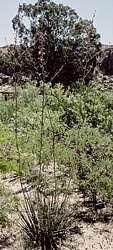 |
Hesperaloe campanulata originates in Nuevo Leon, Mexico and is drought and cold tolerant. It's compact form makes it ideal for small xerophytic gardens.
Photographed flowering at the Boyce Thompson Arboretum, Arizona, May 2006. |
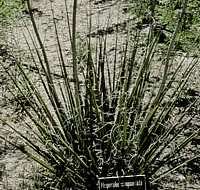 |
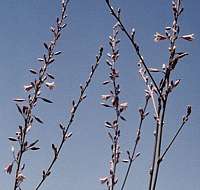 |
|
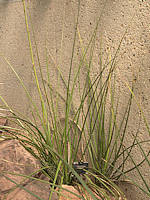 |
 |
Hesperaloe nocturna Gentry 1967 (Night-Blooming Hesperaloe)
This succulent plant has a dense basal rosette of narrow grass-like leaves up to 4 ft long, with white marginal fibres. The inflorescence is a branching stem up to 12 ft long with nocturnal greenish-lavender flowers on its upper portion.
Native to the Mexican State of Sponora.
Photographed flowering at RBG Kew. |
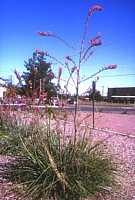 |
Hesperaloe parviflora Coulter 1894 (Red Yucca)
This native succulent plant from West-Texas and North-eastern Mexico is most commonly seen cultivated outside South-western motels and shopping malls as a xerophytic ornamental. A sunny location is required for production of the showy blooms, varying in colour from reds through to pinks. Plants are polycarpic, so unlike most Agaves, Hesperaloe parviflora doesn't die after flowering.
Hesperaloe parviflora grows as a stemless rosette and spreads vegetatively through offsets and rhizomes. It is trouble-free and tolerant of heat, drought and some winter cold although probably only under dry conditions.
Photographed flowering outside the Post Office, Alpine, Texas. October 2003. |
Hesperocallis A. Gray 1868
Greek: hesperius = western + kallos = beauty
Hesperocallis is a monotypic genus for Hesperocallis undulata.
The Family Hesperocallidaceae Traub 1972 was created for this genus but it's usually included in Agavaceae.
|
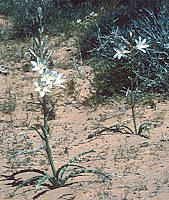
Mojave Desert Reserve, early April 1995 |
Hesperocallis undulata A. Gray 1868 (Ajo Lily, Desert Lily, wild garlic).
Name: Latin undulatus = wavy, referring to the leaf margins.
Common Name: Spanish Ajo = garlic
A large (2 in diameter) underground bulb produces long, narrow, channelled glaucous green leaves with undulate margins. The straight flower stem, up to 6ft tall, bears large white fragrant flowers whose six petals have a greenish to gray mid-stripe. Flowers appear after Spring rains and are pollinated by the sphinx moth.
Native to sandy soils of the arid Mohave and Sonoran deserts of South-Eastern California and South-Westen Arizona, Baja California and the Mexican State of Sonora. The Desert Lily Sanctuary located on Highway 177 was designated by Congress in 1994 to protect these beautiful lilies. The town of Ajo and the Ajo Mountains of Arizona are thought to be named after the bulbs that are common in the area rather than vice versa.
The bulbs were eaten baked or boiled by Indians and settlers as a substitute for onions or garlic. Said to be difficult to impossible in cultivation.
|
Manfreda Rose 1899
There are 28 species of Manfreda, distributed from South-eastern and South Texas, Eastern Mexico and Guatemala. These succulent plants are small and stemless or with a short stem. The fleshy leaves form a loose rosette. Leaf edges are smooth or have very small teeth and there are no terminal spines. The relatively tall inflorescence carries fragrant tubular flowers.
Manfreda species are found from West Virginia to South-eastern Texas, Mexico and Central America. They contain saponins that were used as detergents and were traditionally used as remedies against snake bite. While efficacy against snakebite is doubtful, it is just about possible that the soapy content could help to inactivate the toxic enzymes in some snake venoms.
Polianthes Linnaeus 1753
There are 13 species of Polianthes, found entirely in Mexico. All species are stemless and the thin succulent grass-like leaves do not form an orderly rosette. In some species the leaf bases form a sort of bulb or tuber which offsets by forming bulbils around itself. The sweetly fragrant tubular flowers are used by florists and to make a valuable oil for the perfume industry. The flowers attract nocturnal hawk moths and humming birds.
Polianthes tuberosa is an agricultural crop for the perfume industry and for cut flowers. The tubers with a similar appearance to daffodil bulbs, should be planted just under the surface, and kept slightly damp until leaves appear. The fragrant white waxy flowers are produced on spikes up to 18 in long. However, individual tubers tend to be monocarpic and new flowers can only be obtained reliably by propagating the offsets. In climates with winter frost, tubers should be lifted and stored dry.
Prochnyanthes Zucccarini 1837
This is a monotypic genus from high mountains of Mexico for the species Prochnyanthes viridescens. The base of this succulent plant is bulbous. The plant is traditionally used to treat bites from insects and snakes.
|













